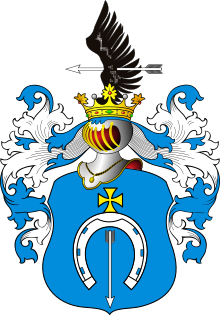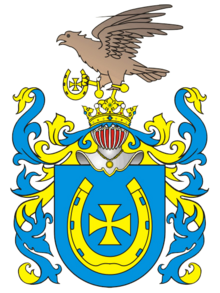The Skłodowski family (originally Skłoty, and later also sometimes Skłotowscy) is a Polish noble family that used the Dołęga coat of arms and Jastrzębiec coat of arms.


History
editThe Skłodowscy family originates from the village of Skłoty (now Skłóty) located in the Płock land. The first recorded member of the family was Velislaus (Welisław) de Sclothowo, who appeared in the Łęczyca court book on June 20, 1391.[1][2] In the 16th century, a branch of the family (using the surname Krasznicki seu Sclothowski) settled in the village of Kraśnica in the Konin County.[3] Descendants of this branch later appeared in Lviv County and the Duchy of Siewierz.[3] They were using a surname Sarnowski.[2] In the 17th century, another branch settled in the Vitebsk Voivodeship of the Grand Duchy of Lithuania.[1]
A significant portion of the family moved to the empty areas in Podlasie and Mazovia during the 15th and 16th centuries, settling the surrounding areas and establishing noble villages (zaścianek). From the 16th century, the Skłodowscy family of the Jastrzębiec coat of arms is known to have lived in the villages of Skłody-Borowe, Skłody Wróble, and Skłody Ziemianie in Podlasie.[4] Another branch settled in Mazovia, in the Nur land, inhabiting the villages of Skłody-Stachy, Skłody-Średnie, and Skłody-Piotrowięta, which are located next to each other along the Brok River, near Zaręby Kościelne.[4] This branch used the Dołęga coat of arms.[4]
This was a typical petty nobility, farming the land and primarily sustaining themselves through their own labor. In the mid-17th century, Maciej Skłodowski, who originated from Skłody-Piotrowięta, achieved a higher standing. A distinguished soldier, he acquired the village of Rząśnik and, after marrying Agnieszka Ponikowska, also came into possession of the villages Ponikiew Wielka and Ponikiew Mała.[5] He engaged in a prolonged legal dispute over these estates with Ludwik Zieliński, the starost of Ciechanów.[5] His son, Seweryn, having no heirs, donated in 1706 the entire estate for charitable purposes and to family members and requested to be buried beneath the threshold of the church in Goworowo.[5]
The aforementioned Maciej Skłodowski had a brother, Jakub, who also had a son named Seweryn Skłodowski. This Seweryn and his descendants lived in Skłody-Piotrowięta. His great-great-grandson was Urban Skłodowski, whose son was Józef Skłodowski, the headmaster of the Lublin gymnasium.[6][7] Józef's son was the distinguished biologist Władysław Skłodowski. Władysław's children, from his marriage to Bronisława Boguska, included the renowned doctors Józef Skłodowski and Bronisława Dłuska, the educational activist Helena Skłodowska-Szalay, and the scientist and Nobel laureate Maria Skłodowska-Curie.[8][9]
References
edit- ^ a b Sadaj 1982, p. 131.
- ^ a b Lasocki 1936, p. 49.
- ^ a b Sadaj 1982, p. 132.
- ^ a b c Sadaj 1982, p. 133.
- ^ a b c Sadaj 1982, p. 134.
- ^ Sadaj 1982, p. 135.
- ^ Lasocki 1936, p. 52-53.
- ^ Kaczorowska 2019, p. 69.
- ^ Lasocki 1936, p. 69.
Bibliography
edit- Kaczorowska, Teresa (2019). "Korzenie najsłynniejszej kobiety świata Marii Skłodowskiej-Curie na ziemi łomżyńskiej". In Frąckiewicz, Małgorzata Krystyna (ed.). Rody i rodziny Mazowsza i okolic. Źródła do badań genealogicznych.
- Lasocki, Zygmunt (1936). "Pochodzenie Marji Skłodowskiej-Curie". Miesięcznik Heraldyczny. XV (4–6).
- Sadaj, Henryk (1982). "Skłodowscy. Przodkowie i współcześni Marii Skłodowskiej Curie" [The Skłodowski Family: Ancestors and Contemporaries of Maria Skłodowska Curie]. Roczniki Humanistyczne (in Polish). XXX (2).